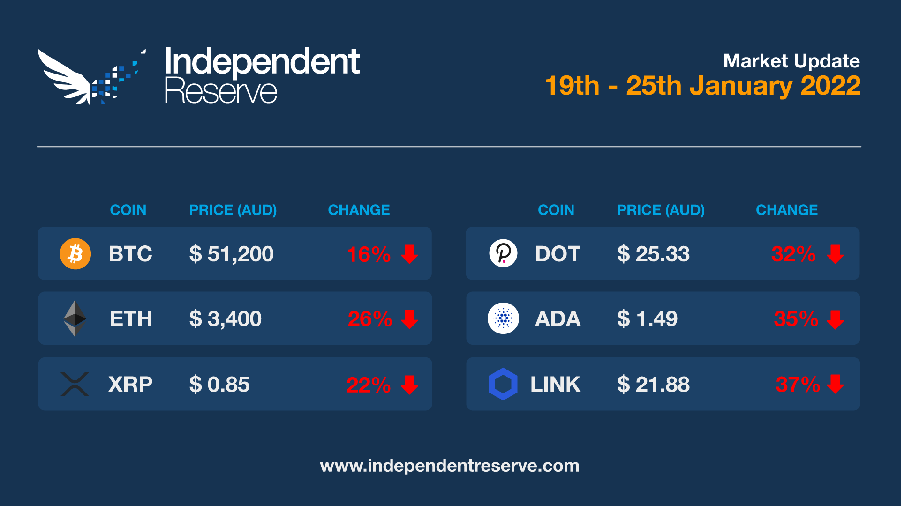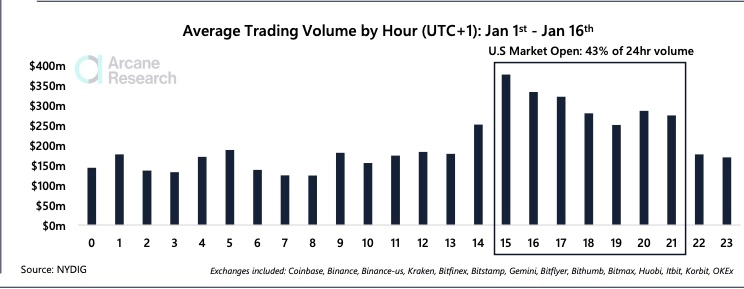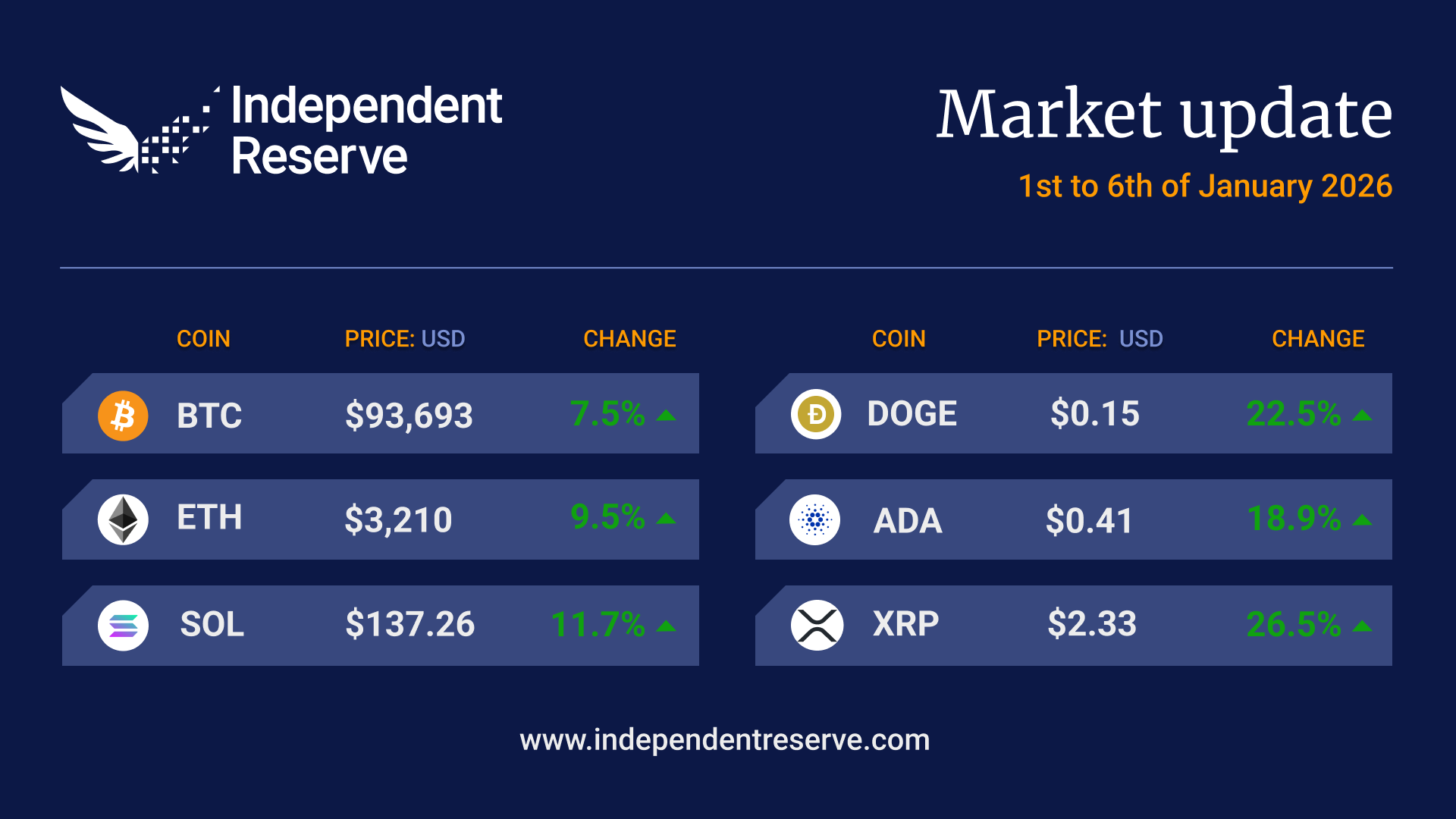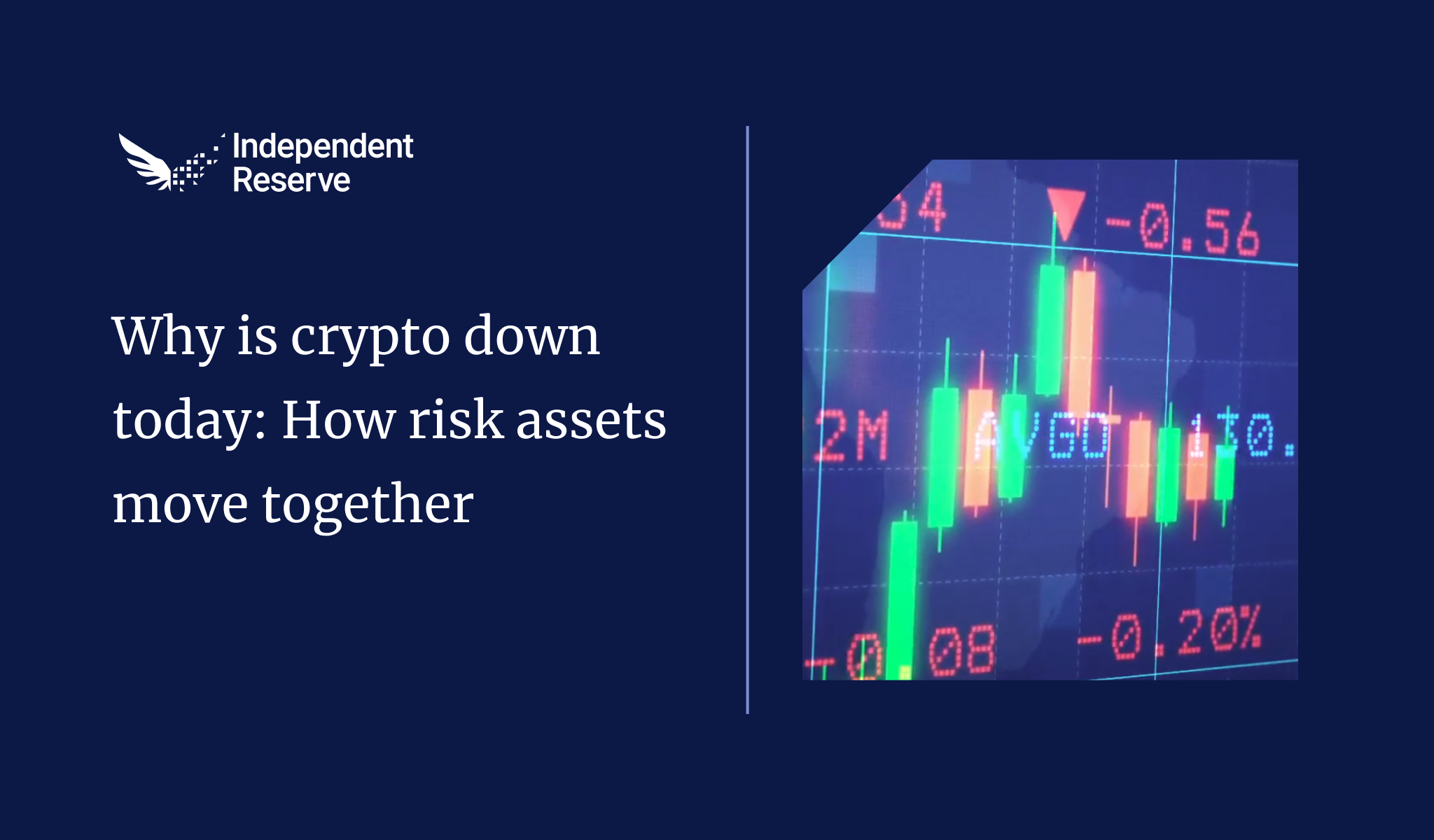In Markets
The party is over, the fluro lights are back on and what seemed a magical playground now looks more like a church hall strewn with empty beer cans. That’s the general feeling this week after crypto markets nuked, wiping half a trillion off the combined market cap. Bitcoin plunged to AU$46,560 overnight (US$32,970) – a 51.6% decline from the all time high in November – but bargain hunters have pushed that back up to AU$51,200, capping the loss at 16% this week. Various analysts have suggested that level may be the bottom, but nobody really knows for sure. The current correction is in the league of the 51% correction from April to May last year and the 60.8% correction from June 2019 to March 2020. We remain at levels last seen in July 2021. The Grayscale Bitcoin Trust Premium plummeted to an all time low of 30%, but El Salvador bought the dip, adding 410 BTC to its stack. Ethereum lost 26%, Cardano lost 35%, XRP (-22%) and Polkadot (-32%). The Crypto Fear and Greed Index is at 13, or Extreme Fear, after dipping to 11 yesterday.

From the IR OTC Desk
Last week, Australia recorded its lowest unemployment rate in more than 13 years, with an Employment Change (Dec) of +64,800 jobs, lowering the Unemployment Rate (Dec) to 4.2% from 4.6% prior. It must be noted that the survey captured the 28th November – 11 December period only, due to labour market disruptions from Omicron. Today, we received Australian Q4 inflation data – the most significant data point for the Reserve Bank of Australia – which highlighted a headline Inflation Rate YoY Q4 of 3.5% and the RBA’s preferred inflation measure, Trimmed Mean YoY Q4 of 2.6% – above the midpoint of the 2-3% band. The RBA are scheduled to meet Tuesday the 1st of February.
China has continued with the theme of credit and housing market stabilisation, on the back of last week’s softer than forecast Q4 GDP release. This week the People’s Bank of China (PBoC) reduced the one year loan rate by 10 bps (from 3.8% to 3.7%) as well as the 5 year loan prime rate by 5 bps (from 4.65% to 4.6%). It is the loan prime rates (LPR) that affect the lending rates for corporate and household loans in the country, with the 5yr LPR referenced for residential mortgages. Continue to watch this space.
In the US, this week brings the all-important January Federal Open Market Committee (FOMC) meeting – scheduled for release at 6:00 am Thursday (AEDT), with the more important press conference from Chair Powell 30 minutes following at 6:30 am. Over the last five days, the NASDAQ has lost circa 5.6%, as the market begins to seek clarification on the path of interest rates and inflation targeting for 2022. Key themes to monitor from the release include: any change to the speed or profile of the QE taper, information and timing of balance sheet reduction, and the expected pathway for any future rate hikes. The US Fed, and the correlation to US tech stocks will continue to prove critical to cryptocurrencies and a key area to watch.
On the OTC desk, sell side flows have continued to be a more dominant theme. Short-dated volatility has moved sharply higher on the week, following quite a significant market compression over the last month. This has led to an uptick in implied volatility across the term structure. Option risk reversals have remained skewed, with put vol. trading significantly higher than calls. The ETH/BTC cross has been a notable mover, beginning the week near 0.075, to now trade around 0.0665. As short-dated volatility picks up in the majors, correlations would usually suggest alts will continue to exhibit outsized moves.
For any trading needs, please don’t hesitate to get in touch.
In Headlines
Trad markets and geo politics
The sugar rush from low interest rates and financial stimulus is wearing off as we emerge from the pandemic. US markets have dropped 8% this year and the ASX is down 4%, with pundits tipping a full blown correction is on the cards, led by heavy falls in tech stocks. The threat of geopolitical conflict between the US and Russia over the Ukraine isn’t helping matters either. The quarterly inflation stats for Australia come out today, which will give an indication of how quickly the Reserve Bank will lift interest rates. In the US a Federal Reserve meeting this week will also let markets know how much pain we are set to feel to fix the 7% inflation rate.
US dominates crypto trade
If you’ve ever wondered why US prices and news dominate the crypto space, that’s because the US has an outsize influence on the space. Arcane Research published a report this week showing US trading hours (3pm to 9pm UTC+1:) account for 43% of the 24 volume of crypto trading on average. “Trading activity tends to immediately pick up as the U.S. stock market opens, with Bitcoin performance being tightly correlated to that of the S&P 500,” Arcane noted, adding the “90-day correlation to the S&P 500 is currently at its highest since October 2020.”

US influence on crypto markets | Arcane Research
Russia says nyet to crypto
Russia’s central bank has proposed banning crypto mining, crypto exchanges and crypto/fiat transactions on Russian territory. In a report on Thursday, it cited threats to financial stability and monetary policy sovereignty and pointed to China’s successful ban. Russians would still be allowed to own crypto however. The Russians transact about $5B ($6.9B) of crypto per year, which isn’t a huge slice of the market however Russia is the third biggest country for Bitcoin mining.
Proposed EU ban on PoW
A top EU financial regulator has called for a continent wide ban on Proof of Work crypto mining. Erik Thedéen, vice-chair of the European Securities and Markets Authority, told the Financial Times that Bitcoin mining was incompatible with climate change goals. “We need to have a discussion about shifting the industry to a more efficient technology,” he said, citing Proof of Stake, which Ethereum is due to adopt this year. Elsewhere Kosovo recently banned crypto mining, but that’s mostly to do with its crippling energy crisis rather than environmental concerns, and Singapore has banned crypto service providers from advertising in public spaces, which hit crypto ATMs in the country.
Congress hearings into crypto mining
In the US the House Energy & Commerce Committee held hearings this week into the energy impacts of cryptocurrency mining, which reportedly uses as much electricity as Norway. While some experts at the hearing suggested renewables are the answer, others pointed out that using renewable power for Bitcoin mining makes the job of switching everything else to green energy that much harder. Ari Juels, a professor at Cornell University, and a co-author of a paper that coined the term “Proof of Work” in 1999 told the hearing that while Bitcoin deserved our “deep gratitude” for introducing blockchains, the time has come to embrace Proof of Stake and other alternatives. The Bitcoin Mining Council this week released its findings from Q4, estimating the amount of miners using renewable energy grew 1% to 58.5%.
Bits and pieces
Solana was hit with a 48 hour outage this week, causing dramas for DeFi users trying to avoid liquidations due to the market plunge. It’s the sixth major network issue in recent months and was blamed on bots. Former Bitcoin bull Raoul Pal (CEO of Real Vision) has revealed he only owns one Bitcoin now. Metaverse gaming company Animoca Brands was stripped of its ASX listing in March 2020 … and is now valued at US$5B (AU$7B) following a $358M (AU$500M) raise. Microsoft bought game publisher Activision (Call of Duty, World of Warcraft) from US$69B (AU$96.5B) as its own Metaverse play. Blackrock has filed with the SEC to create the iShares Blockchain and Tech ETF.
Bitcoin’s transition to a risk-off asset
Bloomberg Commodity strategist Mike McGlone is convinced that Bitcoin will complete its transition from a risk-on asset to a risk-off asset this year despite Fed monetary tightening. While interest rate hikes usually spell out uneasiness for risk-on assets like stocks and crypto, this period may only present a short-term hurdle according to McGlone: “Bitcoin is in a unique phase, I think, of transitioning from a risk-on to risk-off global digital store of value, replacing gold and becoming global collateral.” He’s also stated that the bearish sentiment is a positive sign as the market consolidates. In saying this, McGlone’s outlook for the broad crypto market is not as optimistic, given the large speculation amongst altcoins. “Simple rules of economics do not favor prices of a market where there’s an unlimited supply and ease of entry”.
Until next week, happy trading!


